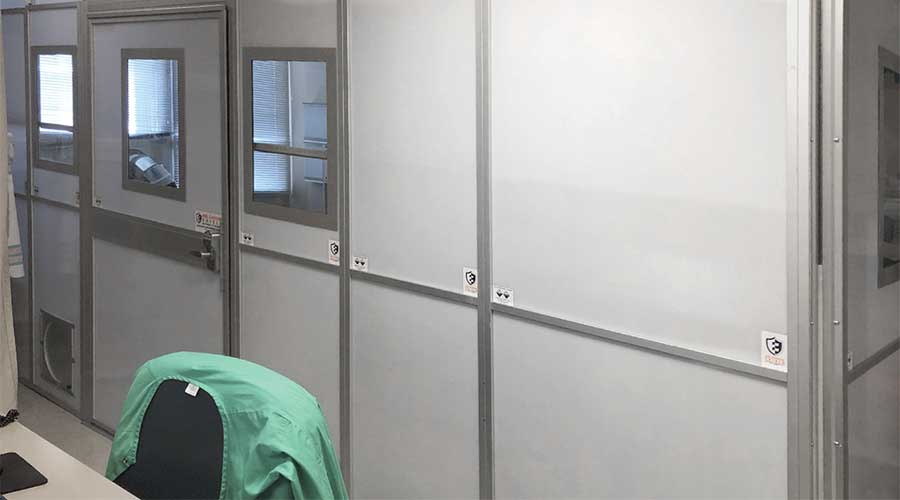While safety is a top priority in any construction project, it is particularly crucial when renovating active healthcare facilities. Construction in such critical environments can generate dust and debris that impact air quality, putting vulnerable patients at risk. Beyond that, the work can also cause excessive noise, vibrations, and other disruptions to ongoing operations. Contractors must take important steps to mitigate these issues and protect the safety and comfort of patients and staff alike.
In 2018, LEMOINE took on a major renovation project for a large hospital in Louisiana. The renovations needed to be done in critical, patient occupied areas–including an emergency department with an EMS bay, a pediatric department, a surgery center, and a NICU. All the while, the hospital would remain open and operational. LEMOINE needed to carry out the construction, while containing dust, limiting noise, and ensuring the hospital maintained a professional appearance.
Traditionally, LEMOINE’s team would contain construction areas by assembling temporary walls made from metal framing and drywall. However, assembling these temporary walls wastes valuable time and resources. The walls take several people working all day to build and require consistent upkeep such as sealing joints and repainting. When construction is complete, construction teams have to tear the walls down.
LEMOINE decided to look for a quicker, easier, and more cost-effective solution to separate construction areas from the hospital's patient-occupied areas.
The Solution
With five years left to complete the project, LEMOINE decided to invest in a reusable temporary wall system that would fulfill its immediate and secondary needs.
Most importantly, the temporary wall system needed to offer:
- The durability to withstand construction and last for several years.
- The flexibility to be quickly adjusted at any point during the project.
- The reliability to help LEMOINE maintain a differential air pressure than that on the patient side of the walls.
Additionally, LEMOINE wanted a system that would be:
- Simple to set up and take down with a small team of workers.
- Mobile for easy transport from location to location.
- Sound attenuation to help lower noise levels within patient areas.
- Fire retardancy to reduce safety risks and meet fire regulatory standards.
LEMOINE selected Abatement Technologies as its temporary wall provider for the project. LEMOINE had previously used the company’s HEPA filtration units, and found that Abatement Technologies’ Shield Wall solution was one of the few solutions available on the market that could meet each immediate and secondary need.
The Benefits
The quality of Abatement Technologies’ Shield Wall™, paired with the ease of use of the panel materials, allowed LEMOINE to assemble the walls in less than a day with just two employees–a process that previously took a team days to complete. The simplicity of the parts and components enabled LEMOINE’s team to set up and move the walls throughout the duration of the project with minimal oversight from team leaders.
LEMOINE also found Abatement Technologies’ Shield Wall system to be extremely customizable. The wall system could easily adjust to a variety of widths and heights and was equipped with swinging, changeable doors. With so many possibilities, LEMOINE decided to assemble the panels into a variety of different designs to discover the best configuration for its needs.
Additionally, the reusable walls pay for themselves over time. Instead of disposing of one-time-use materials like lumber and drywall after the project, LEMOINE can simply decontaminate and take down the temporary walls and compactly store them until they are needed on the next project.
Abatement’s Shield Wall met LEMOINE’s needs at every hurdle. The temporary wall system proved to be a quick, efficient, and cost-effective way for LEMOINE to contain construction areas, maintain the facility’s professional appearance, and ultimately keep the hospital’s patients and staff safe and comfortable.

 Designing Healthcare Facilities for Pediatric and Geriatric Populations
Designing Healthcare Facilities for Pediatric and Geriatric Populations Kaiser Permanente Announces New Hospital Tower at Sunnyside Medical Center
Kaiser Permanente Announces New Hospital Tower at Sunnyside Medical Center Building Disaster Resilience Through Collaboration
Building Disaster Resilience Through Collaboration Amae Health Expands to New York City
Amae Health Expands to New York City Hospital for Special Surgery Opens Two New Facilities in New Jersey
Hospital for Special Surgery Opens Two New Facilities in New Jersey